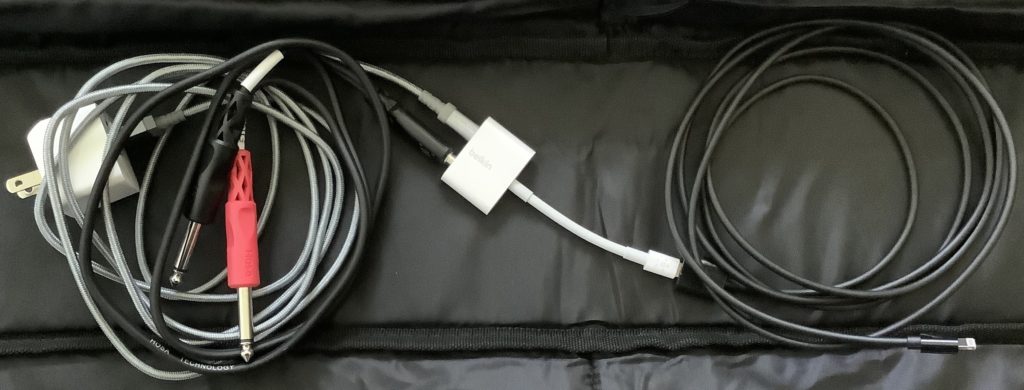Well, as you might have guessed, your Apple iPad synthesis rig cannot be entirely wireless (at least inexpensively so). The audio part ain’t there yet. Bluetooth audio has too much latency and Apple does not provide any other built-in solution. So, it’s wires, again, folks.
In my first post, I discussed the MIDI part: an Apple iPad running Korg Module Pro communicating with a Korg Microkey Air 49 over MIDI BLE. The MIDI part works quite well and I haven’t had any issues.
As to the audio part, I absolutely detest the iPad 3.5mm phone connector. Any plug is exposed and even the slightest movement emits a nasty grind from a powered speaker or other downstream audio device. Buzzzzzz — literally. I simply wouldn’t risk this method in a high volume situation in front of a church congregation.
The Lightning connector, however, is relatively snug and secure. Like most people, I opt for a Lightning-based solution. With Bluetooth handling MIDI duties, one needs only an audio interfacing solution.
Sorry, USB-C people, I don’t have a USB-C iPad and don’t address USB-C solutions here.
By now, everyone knows that the Apple Lightning to USB Camera Adapter is not just for cameras. Thanks to the Camera Adapter, you can hook up a USB-based audio interface to your iPad (or iPhone). The Camera Adapter’s street price has dipped to $9USD, making this a very inexpensive solution. If — if — your bus-powered audio interface draws a small amount of power, the Camera Adapter will supply power although the iPad battery drains faster. If your bus-powered audio interface is a power hog, you will get the infamous “This accessory requires too much power” message and iPad will refuse to play along, shutting down the interface.
Enter the Apple Apple Lightning to USB3 Camera Adapter ($39USD). The USB3 Camera Adapter has two ports: a USB3 host port and a Lightning charge port. The USB3 port connects to your audio interface while the Lightning port connects to an AC adapter. The Lightning port both charges the iPad battery and supplies power to your audio interface.
At one time, I considered the Steinberg UR22C as a solution for both desktop use and mobile. The UR22C has the necessary functional features and sports its own external power port. This is definitely another way to go and I wish more manufacturers would provide an external power port and not rely solely on bus power. I decided to eschew “yet another box at the gig” in favor of an even smaller, lighter solution. (For desktop, I eventually chose the Yamaha AG06, BTW).

For smaller and lighter, I went with the somewhat neglected Belkin 3.5mm Audio + Charge RockStar™ ($40). This Belkin adapter provides a more robust 3.5mm jack and a Lightning charge port. My only beef is the short iPad to adapter Lightning cable. The short cable is good enough for casual listeners, but I feel that it still requires too much stress on the 3.5mm jack. I added a 2 meter Lightning extension cable, letting me rest the adapter and 3.5mm plug on the floor. This arrangement reduces the physical stress on the iPad Lightning port, too. One flexible cable to the iPad makes it easier and safer to move the iPad during a gig.
A few fine points. I configure Korg Module Pro for MONO out and use a 3.5mm stereo to 1/4″ breakout cable (tip and ring) for the final audio connection. MONO is close enough for rock’n’roll. I realize this is audio religion to purists. 🙂
If you don’t want 3.5mm audio, Belkin offers the Belkin Lightning Audio + Charge RockStar™ ($45USD). It has a two Lightning ports: one for audio and one for charge.
Before closing, I want to mention an ultra-cheap, simple solution: an Apple Lightning to 3.5mm Headphone Jack Adapter plus an extension cable. You may already have one of these adapters! When Apple dropped the 3.5mm jack, it began selling these adapters so people could connect their headphones to the jackless iPhone. It’s ultra-inexpensive at $8USD (street).
Check out these related blog posts:
- Wire Less: Part 1, Korg Microkey Air 49
- Wire Less: Part 2, Belkin RockStar™
- Mini review: Korg Module
- SampleTank IOS and Miroslav vs. Korg Module Pro
Copyright © 2021 Paul J. Drongowski
